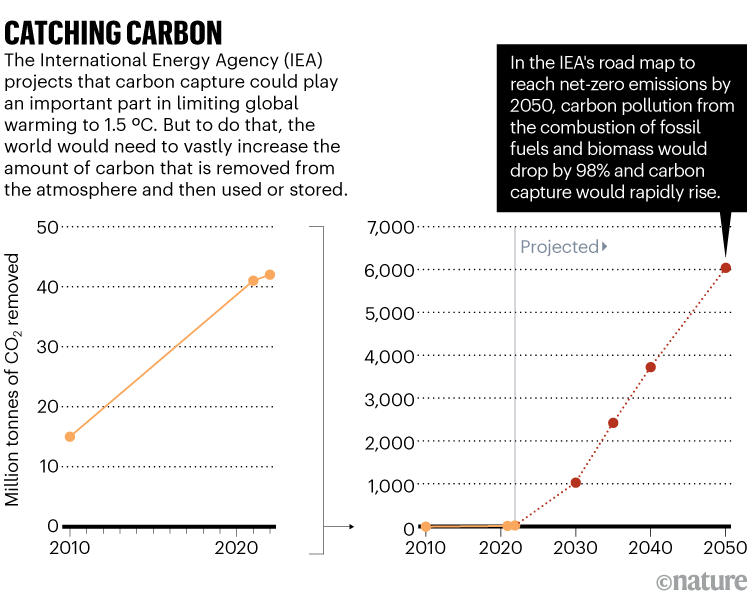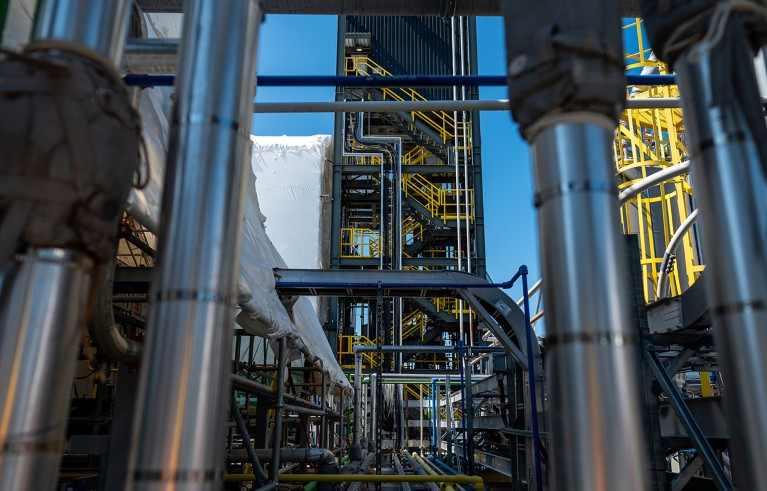Sometime in the next several months, a team of US scientists plans to pour a solution of antacid into the waves off the coast of Massachusetts. Using boats, buoys and autonomous gliders, the scientists will track changes in water chemistry that should allow this tiny patch of the Atlantic Ocean to absorb more carbon dioxide from the sky than it normally would.
The US$10-million experiment, dubbed LOC-NESS, aims to test one prominent strategy to reverse global warming by removing CO2 from the atmosphere. Doing so will be neither cheap nor easy. But with the world looking likely to blow past the temperature targets laid out in the 2015 Paris climate agreement, a growing number of scientists and policy specialists say that carbon removal will be necessary later this century if humanity is to achieve its long-term climate goals.
Earth breaches 1.5 °C climate limit for the first time: what does it mean?
Governments, utility companies and hundreds of start-up organizations around the globe are now investing billions of dollars in carbon-removal strategies that take three broad approaches: sucking carbon directly from the air; altering the oceans to absorb more carbon than normal; and enhancing carbon removal on land. In the United States, for example, companies are planning to build several large-scale ‘direct air capture’ facilities that scrub CO2 out of thin air. And in Europe, power companies are developing a strategy that captures carbon emissions from bioenergy plants that burn woodchips, straw and other plant-based materials: the captured CO2 will then be pumped into the ground beneath the North Sea. Many companies are already selling voluntary carbon-removal credits to organizations such as Microsoft and Google to help them meet their climate commitments. By some estimates, the world might need to remove more than 6 billion tonnes of CO2 from the atmosphere each year by mid-century to meet its long-term climate goals(see ‘Catching carbon’)1.

Source: IEA (go.nature.com/4CAV8A9)
If such approaches succeed, these technologies could help many nations and corporations to meet their climate commitments — and help the world to halt global warming. But the carbon-removal industry faces stiff headwinds, owing in part to a lack of international standards for such technologies and formal commitments by governments. Another major hurdle is a political sea change under US President Donald Trump: the United States had been the largest government backer of research and development for carbon-removal technologies, but Trump is now scaling back climate and clean-energy investments. Most importantly, say researchers, there are also scientific questions about whether the budding market for carbon removal and the technologies can live up to the hype.
This is where academic research projects, such as LOC-NESS, come into play, as a way to test carbon-removal strategies in real-world settings. Although the basic science behind this type of ocean experiment is sound, researchers aren’t sure how it will work in practice. The details matter, says Adam Subhas, a geochemist at the Woods Hole Oceanographic Institution in Massachusetts, who is heading up the four-year LOC-NESS project. “There’s all sorts of activity in the private sector,” Subhas says, “and it’s really critical that the science keeps pace.”
Pulling carbon from the air
The cheapest way to draw carbon out of the atmosphere is to grow more forests, but trees are not necessarily a permanent solution because they might be cut down or burn in fires, which are a growing threat. Many scientists and industrialists therefore focus on more permanent — and more expensive — solutions.
The simplest method is industrial-scale direct air capture, but it’s also the most expensive, costing in the region of $600–$1,000 per tonne of CO2, which is roughly 10 times higher than the price of carbon credits on the European Union Emissions Trading System.

Pulling carbon from the sky is necessary but not sufficient
What will become the world’s largest direct-air-capture facility is expected to start operations later this year in west Texas as a joint operation between two companies: Houston-based Occidental Petroleum and Carbon Engineering in Squamish, Canada. The consortium plans to bury the 500,000 tonnes of CO2 captured each year underground. The group is also developing a second facility as part of a direct-air-capture ‘hub’ that received a $600-million grant commitment from the US Department of Energy (DOE) under former president Joe Biden in 2023. Another $600-million commitment from the DOE went to a second air-capture hub in Louisiana, which features a pair of facilities that will use technology from Heirloom Carbon Technologies, a firm in Brisbane, California, and a Swiss company called Climeworks based in Zurich that operates what is currently the world’s largest direct-air-capture facility, in Iceland.
Both of the DOE hubs will pump the carbon they extract from the atmosphere underground. With funding from an infrastructure law passed by Congress in 2021, the DOE had planned to invest another $2.3 billion in other air-capture projects. But since Trump took office, the DOE has frozen funding for that programme, including money committed to the plants in Texas and Louisiana. It remains unclear whether or when the agency will fulfil even its existing grant commitments, which many specialists fear will threaten the viability of both hubs.

At a plant in Squamish, Canada, the firm Carbon Engineering tests carbon-capture technology.Credit: James MacDonald/Bloomberg/Getty
“We don’t actually know whether the Trump administration will honour these contracts, even though they are legally binding,” says a person who worked in carbon removal at the DOE before being fired alongside roughly 2,000 other probationary employees in February. “It puts a lot of these projects in a really risky place,” says the former DOE employee who declined to be named because of concerns over potential retribution.
Others fear that the Trump administration will take further steps that slow advances in this area, such as freezing funding that was set aside for the purchase of carbon-removal credits on behalf of the US government. There are also concerns that the administration could dismantle an interagency effort dubbed the Carbon Negative Shot, which aims to scale-up technologies and reduce the cost of carbon removal to below $100 per tonne by 2032. The government could have played an important part in advancing research and development, as well as promoting the creation of common standards for an industry that currently operates like the Wild West, says Wil Burns, co-director of the Institute for Carbon Removal Law and Policy at American University in Washington DC. But those efforts “are being swept away” by the new administration, adds Burns. The DOE did not respond to a request to comment from Nature.
Ocean alchemy
One project that seems to be moving forwards for now is LOC-NESS, which has received support through a $24-million public–private research programme coordinated by the US National Oceanic and Atmospheric Administration (NOAA). In August, assuming that the final permits come through, Subhas and his team will release a solution containing 50 tonnes of sodium hydroxide (which is not used as an antacid for humans) alongside an inert tracer dye roughly 60 kilometres off the coast of Provincetown, Massachusetts. The researchers will then monitor the solution as it disperses, reducing the acidity of seawater and enabling it to absorb more CO2 from the atmosphere.
In theory, Subhas says, the biological effects will mostly be minor and positive2, but monitoring during the experiment should help the team to assess potential impacts on shell-building organisms such as phytoplankton and diatoms. Studies using computer modelling suggest that during the week-long field experiment, the researchers should be able to measure how much CO2 is absorbed by the ocean as a result of their intervention.

Start-ups are adding antacids to the ocean to slow global warming. Will it work?
If the team can show that it is possible to monitor and quantify how much extra CO2 is absorbed, the potential for scaling up is significant: with even a small increase in alkalinity, Subhas says, coastal countries around the world could collectively extract one billion tonnes of CO2 from the atmosphere each year, which is roughly equivalent to the annual carbon emissions from Japan and is about 3% of global emissions. Cost estimates vary widely for appoaches that depend on altering ocean chemistry to absorb carbon, but most suggest that they are likely to be cheaper than direct air capture3.
LOC-NESS is just one of 17 projects funded through the NOAA research programme, and so far those efforts are all moving forwards. Other NOAA projects focus on a variety of methods to absorb CO2 in the oceans, including fertilizing the water with iron to grow more phytoplankton and farming seaweed.
The programme intentionally took a diverse approach testing various options. “We’re not at a point yet where we can put together our knowledge and say which methods work at scale,” says a former government employee familiar with the effort. They declined to be named because they were fired as part of mass lay-offs by the Trump administration and fear retaliation.